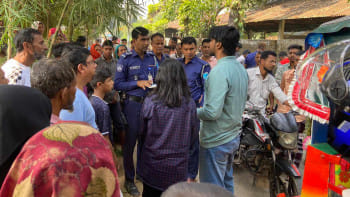Adult Aedes: Capital sees 14-fold rise compared to pre-monsoon

The adult female Aedes mosquito population in the capital is now around 14 times higher than it was in the pre-monsoon period, a government survey has found.
The concentration of mosquito larvae is also much higher, meaning the mosquito population will grow further in the upcoming days, according to the survey, done by the Directorate General of Health Services (DGHS).
Potential breeding sources of Aedes include discarded tires, flooded tires, plastic drums, plastic buckets, water tanks and clay pots, according to the report that says the growing number of adult female Aedes is the key reason behind the ongoing spread of dengue.
Speaking to The Daily Star yesterday, MM Aktaruzzaman, DGHS deputy programme manager for Malaria and Aedes Transmitted Diseases, said people in their houses should take necessary measures; the city corporations should do better solid waste management considering the situation; and under-construction buildings should be monitored strictly.
“People should not be worried. If dengue is detected early and prompt actions are taken, the disease will not be fatal,” he said.
“As there is a huge population movement, the lower Breteau Index (BI) in any place does not necessarily mean lower risk of getting affected,” the report warned.
Breteau Index measures the number of water-holding containers infested with larvae per 100 houses.
The disease, caused by Aedes mosquito bites, has spread alarmingly this year not only in Bangladesh, but other countries in the region, including Pakistan, Nepal, Sri Lanka, Maldives, Malaysia, Thailand, Cambodia, Laos, the Philippines, Singapore and Vietnam, according to the European Centre for Disease Prevention and Control.
In Bangladesh, at least 24,804 people have been infected with dengue as of yesterday and at least 1,870 new cases were reported in the last 24 hours, according to the DGHS.
The DGHS put the death toll at 18 so far, although hospital sources said the viral fever claimed at least 56 lives.
The number could be much higher as many dengue cases go unreported, they added.
On July 17, the DGHS began a survey to measure the mosquito population in the capital based on samples from 1,000 homes spread across 98 wards of the two city corporations.
Data from the sample showed that the concentration level of adult Aedes’s is 487, while it was 36 in the survey carried out in the pre-monsoon period, which was conducted between March 3 and 12 using the same samples.
The density of larvae is also higher.
The researchers took into account BI to assess the presence of larvae. A BI level beyond 20 means there is presence of larvae and is risky for inhabitants.
In the pre-monsoon survey, it was 26 and 21 in the south and north city corporations. The latest findings show 64 and 57.
Researchers found most larvae of the Aedes in water collected over the ground, from which 22.90 percent were in discarded tires, 11.29 in flooded floor (basement or others), and 7.74 in plastic drums, plastic buckets and flower tubs.
Aktaruzzaman also said all the upazila and districts hospitals would be provided with necessary training on Dengue treatment by Thursday.


 For all latest news, follow The Daily Star's Google News channel.
For all latest news, follow The Daily Star's Google News channel. 








Comments